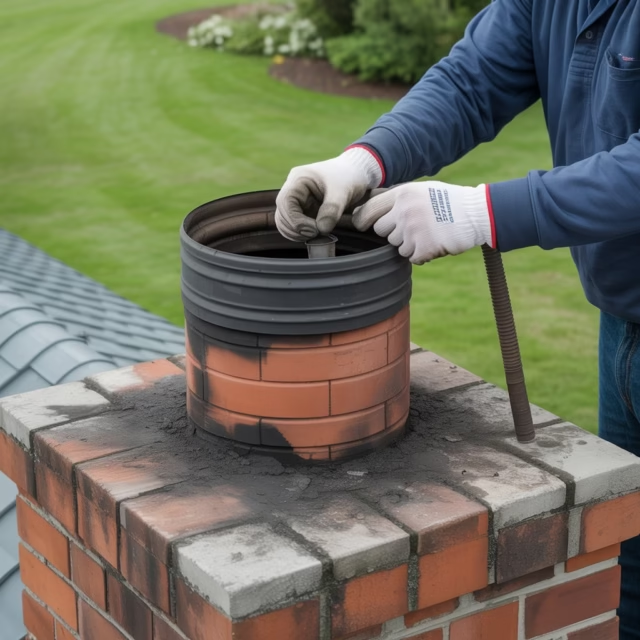Chimney liners are an essential part of residential heating systems, especially in cities like Minneapolis, where winter heating demands are high. Though many homeowners ignore them until something goes wrong, knowing what their expected lifespan is can avoid expensive repairs and enhance home safety. The lifespan of a Chimney Liner relies primarily on its material, use, maintenance, and quality of installation.
Why It Matters
A chimney liner’s main purpose is to protect the chimney structure from acidic gases, intense heat, and creosote deposits. Without an operational liner, toxic gases like carbon monoxide can enter living areas, and the intense heat can cause the masonry of the chimney to deteriorate, resulting in structural collapse. In Minneapolis, where fireplaces and heating devices are used heavily during winter months, chimney liners face tremendous stress.
Common Issues That Impact Chimney Liner Longevity
There are various issues that can undermine the performance and lifespan of a chimney liner. Some of these include:
Creosote Buildup: Heavy creosote deposits from wood burning can cause liners to corrode or crack.
Moisture Invasion: Rain or melting snow penetration through an uncovered chimney can erode the liner over time.
Incorrect Installation: An undersized or poorly aligned liner tends to warp, corrode, or become detached from the flue.
Chemical Exposure: Flue gases from oil or gas units hold acids that damage metal liners unless properly vented.
Thermal Shock: Temperature shock can cause clay tile liners to fracture, particularly in cold weather locations such as Minneapolis.
Such issues not only shorten the liner’s lifespan but also create severe safety hazards if not corrected.
The composition of the liner is the most important consideration in how long it will last:
1. Clay Tile Liners
These are usually put in during older houses and tend to last 30 to 50 years. They are prone to cracking due to thermal stress, but they need regular checking in cold climates.
2. Stainless Steel Liners
High-quality stainless steel liners, particularly those constructed with 316 or 304 alloy, are created to endure 15 to 25 years or more if they are well-maintained. They withstand heat and corrosion damage, which is why they are widely used in Minneapolis homes.
3. Aluminum Liners
These work well with gas appliances but are not for wood-burning fireplaces. They have a relatively short lifespan—usually 5 to 10 years—and are not suitable for Minneapolis’s cold, high-demand weather.
Steps to Maximize Chimney Liner Longevity
Correct care and preventive maintenance can greatly extend the life of your chimney liner. These are important steps homeowners should adhere to:
Annual Inspections: Employ a licensed chimney sweep to inspect for cracks, corrosion, or blockages.
Professional Cleaning: Routine creosote buildup removal avoids damage and enhances airflow.
Cap Installation: A cap on the chimney prevents rain, snow, and debris from entering the chimney, cutting back on moisture intrusion.
Install an insulated chimney liner: Particularly in cold climates such as Minneapolis, an insulated chimney liner ensures internal temperature maintenance, with less condensation and thermal shock.
Safety Considerations
Chimney liners have a direct impact on fire safety. A missing or broken liner heightens the risk of chimney fires, carbon monoxide leaks, and structural decay. The National Fire Protection Association (NFPA) states that all chimneys need to be lined and maintained in good condition in order to ensure compliance with safety standards. In colder climates such as Minneapolis, dangers are intensified through condensation and freeze-thaw action.
According to certified chimney expert Sarah Langford, “A chimney liner is not a piece of equipment—it’s a safety system that prevents fire and toxic exposure to your home.”
Cost Breakdown
Replacing or fixing a chimney liner is broken down into different costs based on material and labor. Below is a general cost guide for Minneapolis homeowners:
| Chimney Liner Type | Estimated Lifespan | Installation Cost (USD) |
| Clay Tile Liner (repair only) | 30 – 50 years | $1,000 – $2,500 |
| Stainless Steel Liner | 15 – 25 years | $2,000 – $3,500 |
| Cast-in-Place Liner | 40 – 50+ years | $3,500 – $5,000 |
| Aluminum Liner | 5 – 10 years | $800 – $1,500 |
| Insulated Chimney Liner | 25 – 30 years | $2,500 – $4,500 |
Disclaimer: Prices are estimates based on chimney size, contractor accessibility, and rates. These are 2025 average estimates.
FAQs
Q: What are the signs that my chimney liner should be replaced?
A: Indications are smoke leakage, deteriorating masonry, rust streaks, strange smells, or poor draft performance. A professional inspection will verify.
Q: Is a chimney safe to operate without a liner?
A: No. Many contemporary building and fire ordinances demand an efficient working liner for safe use.
Q: How often should I inspect my liner?
A: Every year, no matter what material or age. More often is recommended for frequent fireplace users.
Q: Are stainless steel liners the same?
A: No. 316Ti liners provide greater corrosion resistance and are best suited for wood-burning systems in northern climates.
Key Features to Consider When Replacing a Liner
In choosing a replacement chimney liner for your Minneapolis house, consider:
- Compatibility with fuel type (wood, gas, oil)
- UL listing and compliance with NFPA 211
- Availability of insulated chimney liner options
- Warranty terms (some stainless liners come with lifetime warranties)
- Installation by CSIA-certified professionals
- Corrosion-resistant materials suited for Minneapolis weather
Choosing the right features will ensure a longer-lasting and safer liner installation.
Conclusion
The lifespan of a chimney liner in Minneapolis homes depends largely on the type of liner, environmental conditions, and maintenance habits. Though clay tile and cast-in-place liners provide the greatest durability, stainless steel liners are still the most handy and commonly applied. Scheduling regular inspections, prompt repair, and using an insulated chimney liner can ensure performance longevity and protect your home.
Read More: Chimney Sweep







